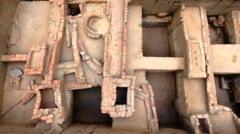The quiet village of Keeladi, nestled in Tamil Nadu’s verdant landscape, has become the heart of an archaeological and political drama that is reshaping historical narratives in India. Excavations have unveiled a trove of artefacts buried deep beneath the soil, igniting debates that intertwine heritage, identity, and politics.
These archaeological finds, estimated to be between 2,000 to 2,500 years old, include fragments of terracotta pots and remnants of brick structures, indicating a sophisticated urban settlement. Since 2014, a series of excavations have uncovered over 15,000 items, such as burial urns, coins, and terracotta pipes, which experts assert reflect a structured society with distinct spaces for living, burial, and industry.
Ajay Kumar, a leading archaeologist on the site, emphasized that these discoveries challenge the long-held view that urbanisation in ancient India was predominantly a northern phenomenon. "This was a literate, urban society, marking the first well-defined ancient civilization found in southern India," he stated, providing a fresh perspective on India's early history.
Keeladi, situated 12 km from Madurai by the banks of the Vaigai river, was strategically chosen for excavation due to its historical proximity to ancient centers of life and previous discoveries of pottery in the area. The finds have reignited pride among Tamil Nadu residents, as articulated by visitors expressing a newfound closeness to their rich heritage.
However, the discourse surrounding Keeladi also highlights a prevailing north-south divide in India’s historical landscape. A prominent theme in this dialogue is the migration narrative where experts speculate that people from the advanced Indus Valley civilization might have influenced urbanization in Keeladi. Kumar shared this idea, suggesting that more studies are necessary for a clearer understanding.
Despite these exciting discoveries, political tensions remain palpable. The transfer of ASI archaeologist Amarnath Ramakrishnan after two excavation rounds in 2017 has raised suspicions of governmental bias against Tamil culture. This suspicion deepened when the Tamil Nadu government accused the central agency of intentionally stifling archaeological progress to minimize Tamil pride.
In June, Tamil Nadu Chief Minister MK Stalin criticized the federal government’s handling of Ramakrishnan’s report, underscoring a perceived onslaught on Tamil culture. Meanwhile, the central government's Culture Minister Gajendra Singh Shekhawat reassured that the findings are under review, igniting further debate.
As arguments continue—ranging from the significance of Tamil Brahmi script to comparisons with Indus Valley finds—Keeladi resonates as a symbol of identity. Journalist Sowmiya Ashok articulates this sentiment well, remarking on how the artifacts reveal connections that transcend the divisions the present may impose.
In the midst of ongoing excavation efforts, Keeladi remains not just a relic of the past, but a lively site of cultural reclamation and historical reinterpretation. As children explore the newly established exhibits at the Keeladi Museum, the ongoing construction of an open-air museum promises to transform Keeladi into a robust educational and cultural hub—a testament to the enduring legacy of ancient civilizations and a reminder of the complex narratives shaping contemporary India.























